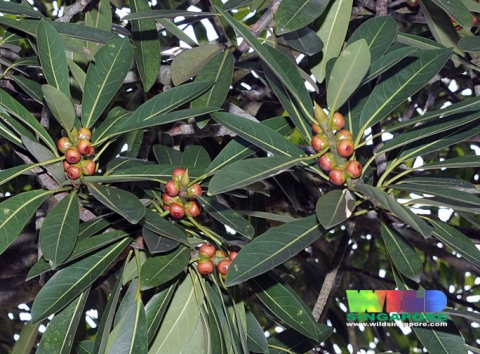Ficus crassiramea
Miq.
Moraceae
Ficus ashtonii Kochummen
Ficus clementis Merr.
Ficus crassicalyx Elmer
Ficus patellifera Warb.
Ficus procera Reinw. ex Blume
Ficus rigida (Miq.) Miq.
Ficus stupenda Miq.
Ficus subgelderi rigida (Miq.) Corner
Ficus subtecta Corner
Common Name:

Fruiting branches
Photograph by: Ria Tan

General Information
Ficus crassiramea is an evergreen tree with a large, spreading canopy; it can grow up to 52 metres tall. The bole can be up to 61cm in diameter[
653- Title
- Plants of Southeast Asia
- Publication
-
- Author
-
- Website
- http://www.asianplant.net/
- Publisher
-
- Year
- 0
- ISBN
-
- Description
- Excellent site with brief information on the plant, its range, habitat and uses, plus phots of specimens, close-ops of flowers and leaves etc,
]. As the tree grows older the bole becomes strongly buttressed[
451- Title
- Flora Malesiana Series 1
- Publication
-
- Author
- Various
- Website
- http://www.archive.org
- Publisher
- Nationaal Herbarium Nederiand, Universiteit Leiden branch
- Year
- 0
- ISBN
-
- Description
- A massive treatment of the plants of the Malaysian Archipelago. Much of it has been made available to download from the Internet
]. It often starts life as an epiphyte in the branch of a tree and can eventually send down aerial roots that, once they reach the ground, provide extra nutrients that help the plant grow more vigorously. These aerial roots can completely encircle the trunk of the host tree, constricting its growth - this, coupled with the more vigorous top growth, can lead to the fig outcompeting and killing the tree in which it is growing[
653- Title
- Plants of Southeast Asia
- Publication
-
- Author
-
- Website
- http://www.asianplant.net/
- Publisher
-
- Year
- 0
- ISBN
-
- Description
- Excellent site with brief information on the plant, its range, habitat and uses, plus phots of specimens, close-ops of flowers and leaves etc,
].
The tree is sometimes harvested from the wild for llocal medicinal use.
Known Hazards
None known
Botanical References
451- Title
- Flora Malesiana Series 1
- Publication
-
- Author
- Various
- Website
- http://www.archive.org
- Publisher
- Nationaal Herbarium Nederiand, Universiteit Leiden branch
- Year
- 0
- ISBN
-
- Description
- A massive treatment of the plants of the Malaysian Archipelago. Much of it has been made available to download from the Internet
Range
Southeast Asia - Myanmar, Thailand, Malaysia, Indonesia, Philippines to New Guinea and the Solomon Islands.
Habitat
An emergent tree in undisturbed to slightly disturbed mixed dipterocarp, (peat)-swamp and coastal forests at elevations up to 100 metres. Usually found on alluvial sites, near or along the sides of rivers and streams[
653- Title
- Plants of Southeast Asia
- Publication
-
- Author
-
- Website
- http://www.asianplant.net/
- Publisher
-
- Year
- 0
- ISBN
-
- Description
- Excellent site with brief information on the plant, its range, habitat and uses, plus phots of specimens, close-ops of flowers and leaves etc,
].
Properties
| Medicinal Rating |      |
| Habit | Evergreen Tree |
| Height | 45.00 m |
| Pollinators | Wasps |
| Cultivation Status | Wild |
Cultivation Details
Found wild in a range of soils from sandy to clay[
653- Title
- Plants of Southeast Asia
- Publication
-
- Author
-
- Website
- http://www.asianplant.net/
- Publisher
-
- Year
- 0
- ISBN
-
- Description
- Excellent site with brief information on the plant, its range, habitat and uses, plus phots of specimens, close-ops of flowers and leaves etc,
].
Fig trees have a unique form of fertilization, each species relying on a single, highly specialized species of wasp that is itself totaly dependant upon that fig species in order to breed. The trees produce three types of flower; male, a long-styled female and a short-styled female flower, often called the gall flower. All three types of flower are contained within the structure we usually think of as the fruit.
The female fig wasp enters a fig and lays its eggs on the short styled female flowers while pollinating the long styled female flowers. Wingless male fig wasps emerge first, inseminate the emerging females and then bore exit tunnels out of the fig for the winged females. Females emerge, collect pollen from the male flowers and fly off in search of figs whose female flowers are receptive. In order to support a population of its pollinator, individuals of a Ficus spp. must flower asynchronously. A population must exceed a critical minimum size to ensure that at any time of the year at least some plants have overlap of emmission and reception of fig wasps. Without this temporal overlap the short-lived pollinator wasps will go locally extinct[
413- Title
- Global Invasive Species Database
- Publication
-
- Author
-
- Website
- http://www.issg.org/database/welcome/
- Publisher
-
- Year
- 0
- ISBN
-
- Description
- Very detailed information on almost 400 species (with more being added) of plants that have become weeds in areas outside their native range.
].
Edible Uses
None known
Medicinal
The roots, bark and leaves are pounded into a past and used against snake bites[
653- Title
- Plants of Southeast Asia
- Publication
-
- Author
-
- Website
- http://www.asianplant.net/
- Publisher
-
- Year
- 0
- ISBN
-
- Description
- Excellent site with brief information on the plant, its range, habitat and uses, plus phots of specimens, close-ops of flowers and leaves etc,
].
Other Uses
None known
Propagation
Seed -
If you have any useful information about this plant, please leave a comment. Comments have to be approved before they are shown here.
 Useful Tropical Plants Database 2014 by
Ken Fern,
web interface by
Ajna Fern
with help from
Richard Morris.
Useful Tropical Plants Database 2014 by
Ken Fern,
web interface by
Ajna Fern
with help from
Richard Morris.